Chemical pollution in Khartoum: Fact or myth?
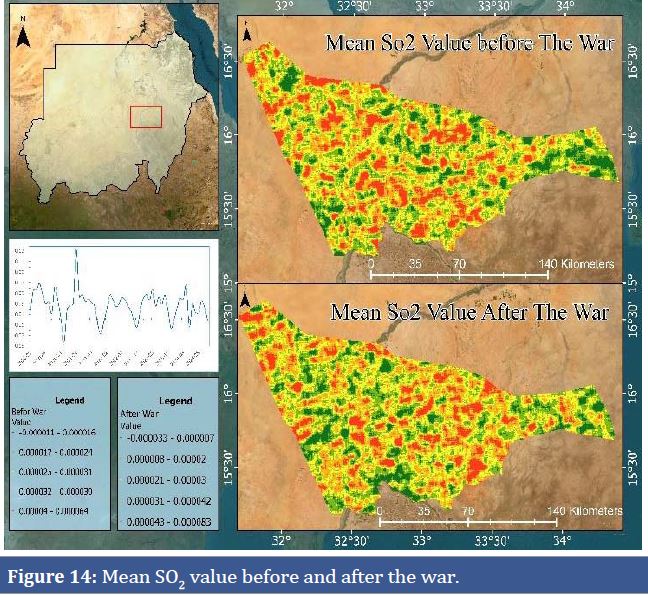
A map showing the air quality in Khartoum and the presence of sulfur dioxide before and after the war
As an increasing number of people displaced by the war return to the Sudanese capital of Khartoum, talk of chemical contamination in the city has increased as a result of the war that raged there from April 15, 2023, until it was recaptured by the Sudanese government forces in April 2025. However, the Federal Ministry of Health took pains on Sunday to deny, that any chemical or radioactive contamination has occurred in Khartoum.
The controversy over the matter returned after the media circulated a statement attributed to the Syndicate of Forensic Doctors indicating that Khartoum is uninhabitable due to chemical pollution. However, the Preliminary Committee of the Doctors’ Syndicate disavowed the statement, stressing that the said Syndicate dissolved itself years ago after the election of the Preliminary Committee, and the committee also confirmed that it could not prove or deny the occurrence of chemical contamination in Khartoum.
Social media influencers, who support the army, circulated information during the battle of the Republican Palace between the army and the Rapid Support Forces (RSF), stating the use of gas, without referring to the sources from which they obtained the information.
In June, the USA imposed sanctions on the military for its use of chemical weapons. The New York Times reported in January that the Sudanese military had used chemical weapons at least twice in remote areas during its war with the Rapid Support Forces (RSF).
The newspaper also quoted unnamed US officials as saying that the weapon used appeared to be chlorine gas, which can cause severe respiratory pain and even death, while Khartoum denied using chemical weapons.
Activists on social media also relied on the authorities’ decision to evacuate central Khartoum and relocate all institutions to foreign countries, which they considered an indication of the validity of what they said was the presence of pollution, but the authorities said they made the decision because of the high cost of maintenance and the focus on providing electricity and water services.
Chemical pollution and acid rain
In a workshop held in Port Sudan in October 2024, the Secretary General of the Supreme Council for Environment and Natural Resources, Dr Mona Ali Mohamed, said that Khartoum State was exposed to chemical pollution due to the Rapid Support Forces (RSF) striking industrial zones, pointing to the need for concerted efforts to find solutions to this problem.
During a training workshop on the dangers of chemicals at the customs hall in Port Sudan, she said that the state of Khartoum in particular needs a great effort to avoid any possible negatives.
She added that chemical pollution is common, due to the presence of chemicals in many products to varying degrees, and they are capable of causing pollution, which requires intensive awareness at the national, state and local levels, and at the level of individuals.
Ali Mohammed made the same statement during her address to the Conference of Arab Ministers of Environment (35th session) held in Jeddah in October last year, where she confirmed that Khartoum and its neighbors were exposed to very large chemical pollution as a result of the targeting, and Khartoum witnessed acid rains that were monitored through satellite aerial images, due to the Rapid Support Forces’ targeting of five industrial zones in the capital: Three in Bahri (the largest), another in Omdurman and Khartoum, in addition to Iyad Industrial and Yarmouk Industrial Estate.
She referred to a report prepared by the Supreme Council for Environment in cooperation with UNEP from the first day of the war, within the framework of preparing a scientific plan to determine the environmental effects of this war, noting that the report clarified the great environmental crime committed against the Sudanese people and was overlooked by the world.
In her speech, she said: “The industrial centres are concentrated in the capital: three cities in Bahri, the largest of which are in Omdurman, Khartoum, Gyad Industrial and Yarmouk Industrial Zones, which are five industrial zones that were targeted, and they contain chemicals, so Khartoum and its neighbors witnessed very large chemical pollution as a result of the targeting, and Khartoum witnessed acid rain that was monitored through aerial satellite images.”
Ministry of Health denial
The Federal Ministry of Health said that the data received from the competent national agencies concluded that there is no scientific evidence to support the claims of chemical or radioactive contamination in Khartoum, as official measurements and reports showed that the general situation does not pose a threat to public health.
In a statement on September 1, it said it reached this conclusion based on the evidence and programs available from field measurements, the health monitoring system, and official medical reports, stressing that there is no evidence that the capital has become uninhabitable. The Federal Ministry of Health stressed the importance of continuing periodic follow-up through health monitoring and careful examination to ensure an immediate response to any potential health emergency.
The ministry did not specify the nature of the competent national authorities or parties involved in the verification.
The ministry pointed out that the competent national authorities have embarked on scientific verification and monitoring operations since the beginning of April 2025, following the liberation of the capital, after media campaigns that talked about “the uninhabitability of the capital” as a result of allegations related to radioactive pollution, the use of chemical weapons and environmental degradation.
The Ministry pointed out that radiation measurements are being carried out using devices approved by the International Atomic Energy Agency (IAEA) in specific locations: Al-Mawra Hospital, Astak Laboratory, and Veterinary Research Laboratory in Soba.
Chempo certified by the Organization for the Prohibition of Chemical Weapons (OPCW) field detectors, as well as the follow-up of the National Epidemiological Investigation System of the Federal Ministry of Health to monitor any unusual cases, forensic and forensic reports, and continuous follow-up from the Forensic Medicine Advisory Council of the Federal Ministry of Health have also been used.
She explained that the most prominent results and outputs are that no rise in radiation levels or movement of radioactive sources was recorded, and no unusual residues or munitions associated with chemicals were found.
It noted that the results of the field examination did not show toxic evidence or chemicals.
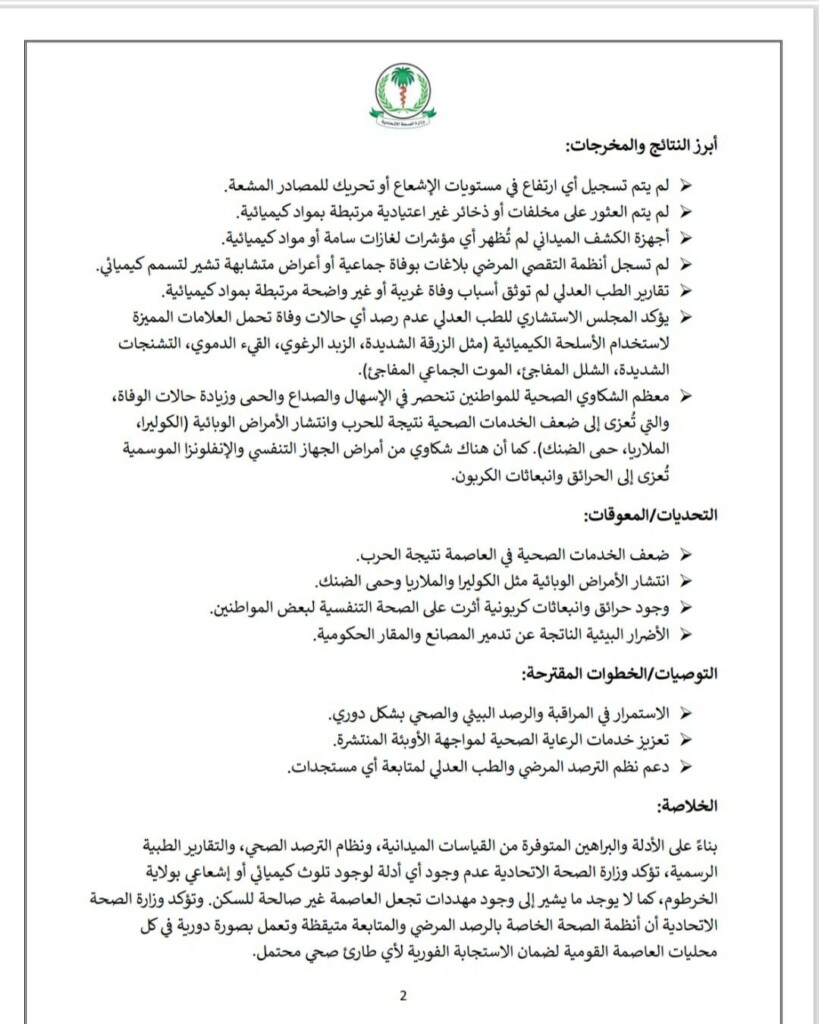
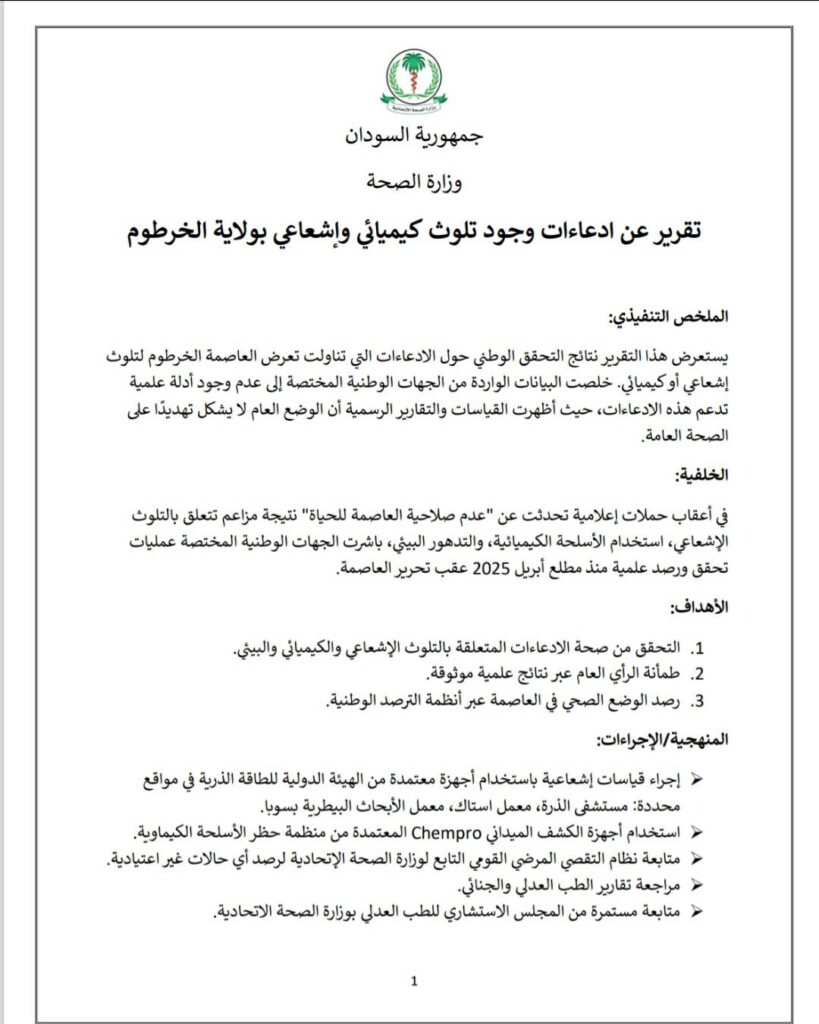
Reports of miscellaneous diseases
The Ministry confirmed that the epidemiological investigation systems recorded reports of individual diseases that do not indicate mass chemical poisoning, noting that the forensic reports did not document strange or unclear causes of death related to chemicals.
She stressed that the National Consultant of Forensic Medicine has not monitored cases of deaths with characteristic signs of exposure to toxic substances (such as pulmonary irritants, bloody vomiting, convulsions).
She noted that most of the health complaints received are related to symptoms of diarrhea, headache and fever, which may be related to common environmental diseases (malaria, cholera, seasonal influenza).
It pointed to the monitoring of environmental damage related to the destruction of factories and government headquarters.
Regarding the challenges facing the verification work, the ministry said that the weakness of health services in the capital as a result of the war represents the first challenge, in addition to the spread of epidemic diseases such as cholera, malaria and dengue fever, as well as the effects of the catastrophic conditions on the mental health of some citizens.
The report recommended continuing environmental and health monitoring and monitoring periodically, enhancing health readiness to face widespread epidemics, in addition to activating the pathological monitoring system and forensic medicine to follow up on any developments.
Technical opinion
Consultant Pharmacist and Environmental Expert at the Delta Center for Scientific and Environmental Studies and Research, Dr. Taha Al-Taher Badawi said that talking about pollution, especially in agricultural areas, requires a double scientific effort.
Badawi said in an interview with “Radio Dabanga” that the effects of pollution are represented in a range of phenomena such as: fires, explosions, elements emitted by gunpowder, heavy chemical elements, shrapnel and unexploded projectiles, destruction of ecosystems, pollution of water, air and soil, destruction of ecosystems and loss of biodiversity, effects on vegetation and continental cover, destruction of civil, industrial and residential infrastructure, and the spread of corpses.
The environmental expert added that chemical pollution needs scientific concepts that can be measured through laboratories, and it needs a scientific effort and scientists who monitor it, and it is one of the most dangerous types of pollution and causes death to all people who are affected by it.
He explained that talking about chemical pollution in a certain area requires linking a number of things to each other, starting with the incidents that caused this pollution, measurements made through laboratories, and reaching and publishing the results under the shadow of ruling groups that are convinced of this.
He warned that chemical pollution affects people in the short and long term, pointing out that it is one of the most dangerous phenomena that must be dealt with with caution, skill and scientific understanding through specialists and consultants.








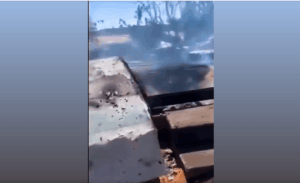
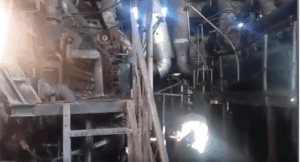

 and then
and then